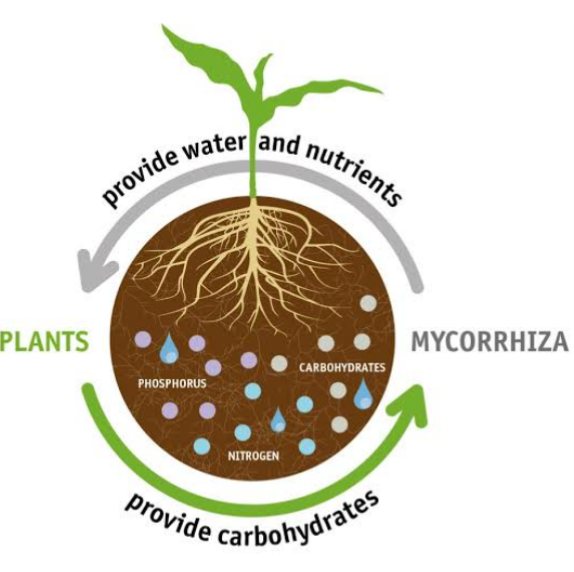
Atimes plants grow in uncondusive environments and if left alone, they might not be productive. Such uncondusive environments or conditions may include water shortage, depleted soils, saline soils, soils with low pH, etc. Therefore, such plants growing under such situation do develop mechanisms for survival. Such mechanisms include
1. Thickened, small or narrow leaves to reduce water loss. This slows down the plant’s growth rate. Small leaves mean less evaporative surface per leaf.
2. Developing tolerance for high salts and low levels of nutrients.
3. Small leaf to control temperature. Small leaves in the sun does not reach high temperature as compared to large leaf.
4. Leaves and stems of many desert plants have a thick, waxy covering, keeping the plants cooler and reducing evaporation loss.
5. Some desert plants grow leaves during the rainy season and then shed them when it dry season. This they do to conserve water and food gathered during rainy season.
6. Plants like black brush photosynthesize in their leaves during wet periods and in their stems during drought.
7. Spines or hairs shade plants and break up drying winds across the leaf/stem surface.
8. The roots of desert plants are also adapted to help them survive. Some plants have shallow, widespread roots to absorb a maximum of rainfall moisture. Others have deep taproots to get water that is deep underground.
9. One important survival mechanisms used by almost all plants involve creating mutually beneficial (symbiotic) relationships between plant roots and soil-borne organisms such as bacteria and fungi. Such symbiotic relationship between plant roots and fungi is called mycorrhizae.
MYCORRHIZAL FUNGI
The term mycorrhiza is two Greek word “Myco” meaning fungus and “Rhiza” meaning root. It refers to the role of the fungus in the plant’s rhizosphere, that is, its root system.
Mycorrhiza is a symbiotic association between micro organisms and plants. The relationship is tripartae ( that is, 3 folds). In nitrogen fixing plants. The relationship exist between
a) mycorrhizal fungi
b) host plants
c) Rhizobium
In shrubby non legumes, the association is between
a) the green plants
b) mycorrhizal fungi
c) Actinomycetes frankia (rhizobium)
In a mycorrhizal association, the fungus colonizes the host plant’s root tissues, either intracellularly as in arbuscular mycorrhizal fungi (AMF) , or extracellularly as in ectomycorrhizal Fungi (EMF) . The association is normally mutualistic. In particular species, or in particular circumstances, mycorrhizae may have a parasitic association with host plants.
In the symbiotic association, the plant makes organic molecules by photosynthesis and supplies them to the fungus in the form of sugars or lipids, while the fungus inturn supplies the plant with water and mineral nutrients, such as phosphorus, taken from the soil.
FORMS AND DISTRIBUTION OF MYCORRHIZA
Association of mycorrhizal fungi is with nearly all plants but certain species are less affected than other.
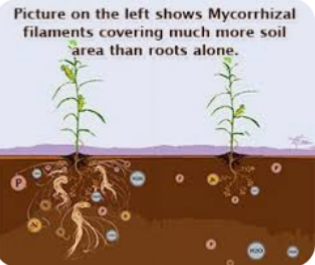
There is a general relationship between the occurrence of root hairs and mycorrhizal formation. Species with many fine root hairs like grasses are not as dependent on fungal partners for nutrition compared to tap rooted species of legumes or coarse rooted plants such as orange trees and Pines. Those plants that form mycorrhiza have common attributes. That is, they control the potential of pathogenesity of fungi.
Fungus rhizoctonia is a potent pathogen of maize. But forms stable mycorrhiza with orchids.
HOW MYCORRHIZAE GET INTO A SITE AND CARRY OUT THEIR DUTIES
When seeds are planted in Soils without mycorrhiza fungi, as the plant grows, it’s roots begin to search for nutrients at part of the soil where they grow, leaving other parts of the soil with nutrients. When the nutrients at that area are exhausted, the roots will grow extensively to other areas using the plant energy store. But when spores on mycorrhiza fungi are introduced to the soil, the roots of the plant will send out signals in the soil. The signals will trigger the spores to begin to grow hyphae which will penetrate into the roots for exchange of resources.

In due time, the hyphae will grow extensively in the soil and tap nutrients at areas the root cannot get nutrients, even in between small pores around the roots which will be exchanged with the plants.
Many soils and desert soils already have spores of mycorrhizal fungi present in them. The quantity of the spores might be small. Therefore, If plants grow where there are spores of these fungi, then both will thrive. The mycorrhizal fungi may continue to survive even after the original host is no longer present.
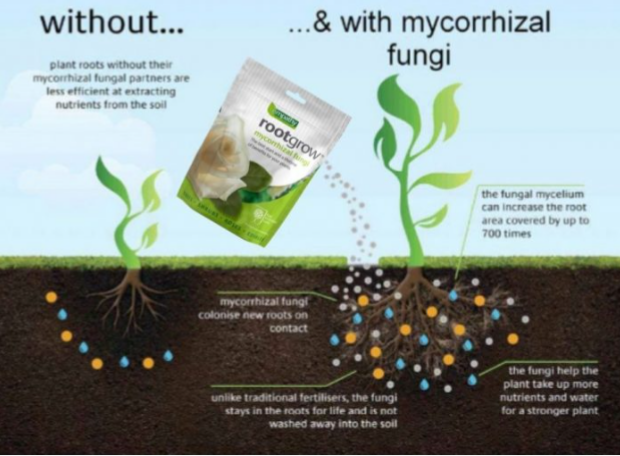
VESICULAR-ARBUSCULAR MYCORRHIZAE (VAM)
VAM/AMF are the most common of mycorrhizal form. They are classified as zygomycetes. They are endomycorrhiza and are aseptate.
The spores of the fungi can naturally exist in the soil or added through inoculation. The spores grow and enter the root and create swellings (vesicles) on the roots. The fungus use the vesicles to store nutrient. The nutrients are then transferred from the fungus to the plant’s arbuscules. And the plants Inturn supply nutrients to the fungus. Thus, the names of these two structures are combined into “vesicular-arbuscular mycorrhizae” (VAM), which is the most common type of mycorrhizal association.
Note: Soil environments in which water and nutrients are in abundant do not require the assistance of mycorrhizal fungi. Therefore, mycorrhizal fungi may not germinate and grow in such environments.
TYPES OF MYCORRHIZAE
All mycorrhizae can be classified into two groups based on where the fungi colonize on the plants. The groups include
1. ECTOMYCORRHIZAE (EXTERNAL ): the fungus produces a dense hyphal sheath around the root’s surface. This is known as the mantle.
The sheaths of hyphae then grow into the root and out into the soil. The hyphae do not penetrate individual cells within the root.
Ectomycorrhizal relationships are characterized by an intercellular surface known as the Hartig Net. The Hartig Net consists of highly branched hyphae connecting the epidermal and cortical root cells.
Ectomycorrhiza only form mutual symbiotic relationships with woody plants, such as beech, willow, pine, oak, spruce, and fir.
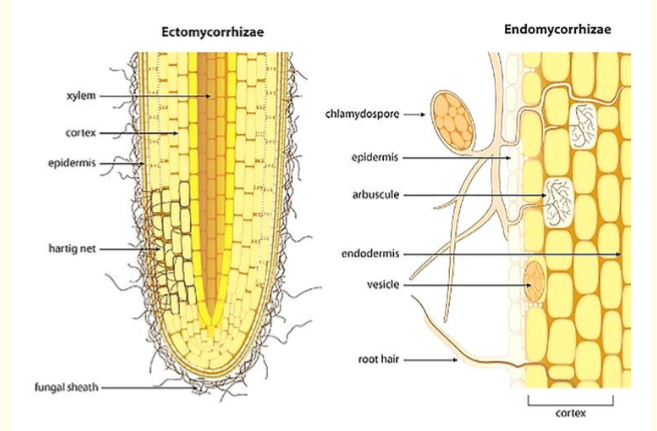
2. ENDOMYCORRHIZAE (INTERNAL ) : This fungi do not produce a sheath; the hyphae grow within the cells ( that is, from the cell wall to invaginate the cell membrane) and out into the soil. The fungus hyphae penetrate the cortical cells of the plant roots and form arbuscules and vesicles. The endomycorrhiza uses an exchange mechanism of nutrients and water inside the root of the plant and the fungi’s hyphae extend outside the root.These are far more common than the ectomycorrhizae. Examples of Endomycorrhiza includes Arbuscular Mycorrhizae, Ericaceous Mycorrhizae, Arbutoid Mycorrhizae, and Orchidaceous Mycorrhizae.
Endomycorrhizae are found on plant species including crops and greenhouse plants such as most vegetables, grasses, flowers, and fruit trees.
IMPORTANCE OF MYCORRHIZAE.
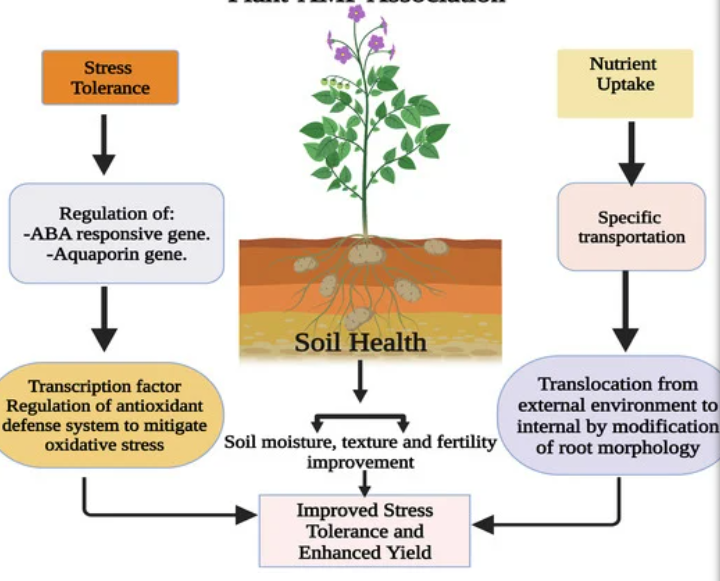
1. NUTRIENTS AND WATER
Mycorrhizae are essential in places like deserts where soils are deficient in water and certain nutrients. Even when nutrient are in sufficient quantity, they might not be readily accessible to the plant. Then mycorrhiza is needed. Plants need Mycorrhizae to be able to absorb more moisture and nutrients from the soil especially in uptake of phosphorus.
The presence of mycorrhizae in Soils makes plants less susceptible to water stress. The fungal hyphae also help to store water and nutrients and make them available when rainfall is sparse and temperatures are high. Mycorrhizae also play a major role in making nutrients in organic matter like compost available when added to improve soil health and fertility . The residual organic matter and the hyphae improve the structure of the soil. Recent research indicates that the fungi even help break down rock, increasing availability of the essential nutrients such as potassium, calcium, zinc and magnesium in soils.
2. DISEASE RESISTANCE
Mycorrhizae also help the plant resist infection by other fungi and even bacteria. When plant are well nourished, they become more healthier and develop resistance to the invaders. Also the physical presence of one fungus can impede infection by others fungi. Plant or the fungus can also produce compounds that would wade away pathogens that can creat infection.
Studies have found that plants with mycorrhizal associations are more resistant to certain soil-borne diseases. Sheathing Mycorrhiza can create a physical barrier between pathogens and plant roots. They thicken the root’s cell walls through lignifications and the production of other carbohydrates to prevent entry of pathogens into the root. They stimulate plant to produce metabolites that works against pathogenic invasion on the plants. In addition to disease resistance, mycorrhizal fungi can also impart its host plant by creating resistance to toxicity and resistance to insects. 3. INTERACTION WITH OTHER SOIL MICROBES
Some micro organisms in desert soils do fix nitrogen in the soil for plants growing in such area to grow. This interaction between the Desert plants and soil micto organisms is important for the plants to survive. When mycorrhizae are present in the soil, the number of the nitrogen fixing micro organisms increase. This therefore improves plant‘s health and vigour and also the fungi improve in health and vigour.
4. IMPROVE SOIL STATUS
Mycorrhizal fungi are also able to change the soil environment in the favor of the host plants. They improving soil structure and quality. The filaments of mycorrhizal fungi create humic compounds, polysaccharides, and glycoproteins that bind soils particles, increase soil porosity, and promote aeration and water movement into the soil.
5. NITROGEN FIXATION
Some ectomycorrhizal associations create structures that host nitrogen-fixing Bacteria. This makes them play a vital role in the nitrogen cycle. They do not fix nitrogen themselves. They also contribute to the amount of nitrogen taken up by plants in nutrient-poor environments,
EXAMPLES OF MYCORRHIZA
1. ORCHID MYCORRHIZA
Orchids and mycorrhizal fungi have a complex symbiotic association where each of the orchid’s life stages are dependent at some level on specific fungi. Some orchids cannot photosynthesize prior to the seedling stage. In the earliest stages, orchids rely entirely on their mycorrhizal fungi for all nutrients, including carbon while the fungi receive carbohydrates in return.
orchid seeds form symbiosis with orchid mycorrhizal fungi to receive nutrients for germination and further protocorm development. When the seed coat ruptures and roots begin to emerge, the hyphae of orchidaceous mycorrhiza penetrate the root’s cells and create hyphal coils, or pelotons, which are sites of nutrient exchange.
2. ARBUSCULAR MYCORRHIZA
Arbuscular mycorrhizae are the most widespread of the micorrhizae species. The fungi belongs to members of an ancient phylum of fungi, the Glomeromycota and family zygomycota. They are obligate symbionts. In other words, the fungi cannot grow in the absence of their plant host and are well known for their ability to supply water, phosphorus and nitrogen to host plants. In return, up to 20% of plant-fixed carbon is transferred to the fungus. They form arbuscules, which are the sites of exchange for the nutrients in the root cells.
3. ERICACEOUS MYCORRHIZA
Ericaceous mycorrhizae are endomycorrhiza found on plants of the order Ericales and in acidic environments. The fungi initially grow on the surface of hair roots, establishing loose hyphal networks then they penetrate and invaginate the root cells, ericoid mycorrhiza do not create arbuscules. They help regulate the plant’s acquisition of minerals including iron, manganese, and aluminum. The ericoid mycorrhiza differ from the other mycorrhizae due to the formation of fine compact intracellular hyphal coils in the rhizodermal cells of hair roots. The coil is the site for transferring nutrients absorbed by ericoid Mycorrhiza fungi from the soil to root cells and carbohydrates fixed by plant photosynthesis to fungi.
4. ARBUTOID MYCORRHIZA
Arbutoid mycorrhiza are a type of endomycorrhizal fungi that look similar to ectomycorrhizal fungi. They form a fungal sheath that encompasses the roots of the plant; however, the hyphae of the arbutoid mycorrhiza penetrate the cortical cells of plant roots, differentiating it from ectomycorrhizal fungi.
5. ECTOTROPHIC MYCORRHIZA
The fungi are from the families Ascomyota and Basidiomyota . They are found in many trees in cooler environments. They forms 2 sheath layers around the roots of a plant, the inner layer forming a sense mesh of hyphae, called the hartig net. The fungi are not adapted to degrade cellulose and other plant materials; instead, they derive their nutrients and sugars from the roots of their living plant host. They do cause an increase in root branching.

BENEFITS OF MYCORRHIZAE
Mycorrhizae may provide the following benefits:
1. Increased absorption of nutrients and water by plants
2. Reduced demand for fertiliser as the tap all nutrients not reachable by plant roots in the soil
3. Enhanced resistance to drought
4. Produce substances that help plant resist pathogens
5. Enhanced soil health and improve soil structure
Improved transplant success
MAINTENANCE OF MYCORRHIZAL FUNGI IN THE SOIL
Though mycorrhizal fungi occur naturally in the soil, application of pesticides like fungicides eventhough can be effective against plant disease, they can destroy beneficial fungi in the soil. Use of heavy machinery, leaving the soil for weeks without any vegetation on top, soils around commercial properties etc, all may cause destruction of mycorrhizal fungi or drastic reduction in the fungi in the soil.
